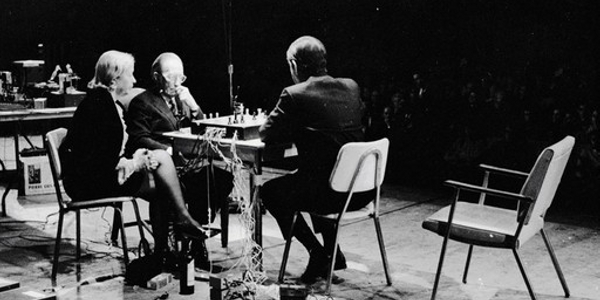
Marcel Duchamp and John Cage playing chess (photo: Shigeko Kubota)
In an e-mail exchange with the English bassist Squarepusher (Tom Jenkinson) about a concert in Amsterdam, he confused me by writing that he did not consider himself a musician, and he was not even sure if he really liked music. Jenkinson is a drummer as well as a bass player, and ever since his first album, Feed Me Weird Things, released in 1996, he has been more or less idolized as an innovator of electronic music.
His music was used by filmmaker Sofia Coppola as the sonic translation of Tokyo’s lightscape in Lost in Translation. It has been presented in manic and sterile fashion by video-maker Chris Cunningham and recorded as a contemporary pendant of 20th-century experimental music by the London Sinfonietta, in a programme of such great composers as John Cage and Karlheinz Stockhausen. Why would anyone of such stature not want to call himself a musician?
In search of an explanation, I called on a number of friends in the music scene and asked what their definition of music was, and whether you could make music without being a musician.
Nearly a century ago, the French composer Edgard Varèse referred to music as ‘organized sound’, a term that was reinforced in 1937 by John Cage in his famous lecture, The Future of Music: Credo. Some theorists see music as a language that enables interaction between people. Others see it as organized movement of air. Philosophers sometimes speak of a ‘practical form of philosophy in time and space’ (I kid you not). The Scottish sound theorist, Steve Goodman, speaks of music as a form of architecture that makes it possible for people to acoustically take control of their environment. As an example, he refers to South London’s dubstep producers, who want to cut off the intrusive noise of their immediate environment and the outside world and by using music equipment to carve out a space in sound.
With any of these descriptions, the question remains whether you can make music and not be a musician, as Jenkinson implies. Most people reply that, yes, you can. You can be ‘tone deaf, not master any instrument or forget to pay your membership to the Musicians Union’, as Ollie Bown of the Icarus electronic ensemble jokes. You might only call yourself a musician ‘if the context requires it and if it is less confusing to call yourself a musician, instead of an artist or theoretician’, as Bown’s cousin and composer Sam Britton pragmatically replies. You can make music and not be a musician ‘by working as an artist in the auditive domain’, adds Lucas van der Velden of the artists collective Telco Systems, or indeed, according to producers Kode9 and Cinnaman ‘by simply not caring what you call it’.
The answers vary from self-effacing to convincing and from indecisive to indifferent. If a distinction can be made between capable musicians who refine and develop their art according to a tradition, and ‘musicians’ who experiment with apparatus and instruments with no notion or interest in history, then perhaps Jenkinson is right. But can such a distinction be made?
Jenkinson also wrote, ‘I see myself as someone who clears the way for musicians and composers, brushing away preconceptions about what is permissible.’ Perhaps Jenkinson’s words indicate that it is ultimately about the experience of music, not about qualifying or analyzing it.
A final word goes to the buoyant Swiss artist Dimitri Grimm (Dimlite), whose e-mail response to my question of whether or not he is a musician was, ‘A loud no and an even louder yes. It depends on who is asking. That question almost never needs a reply (maybe for the phone book entry). The title “musician” is not really laden with a concrete association in my world. I have never learned the definition of a musician, so: I don’t know. There was a time when I used to say, “well, call me a music-maker”, out of respect, because I am not that guy who is reading or writing notes and mastering the craft of, let’s say, guitar playing. That is a musician, right? I grew up in a time when people scratching with turntables had already started calling themselves musicians. These days, we juggle zeros and ones by ear and eye, create sounds, rhythms, harmonies, melodies and good and bad ghosts of all sorts, by any means, for ears and souls, and it takes a lot of mastery. It is nobody’s right to decide who is a musician and who is not, and if they do, who cares?’
This article was published in Metropolis M of February/March 2009.




